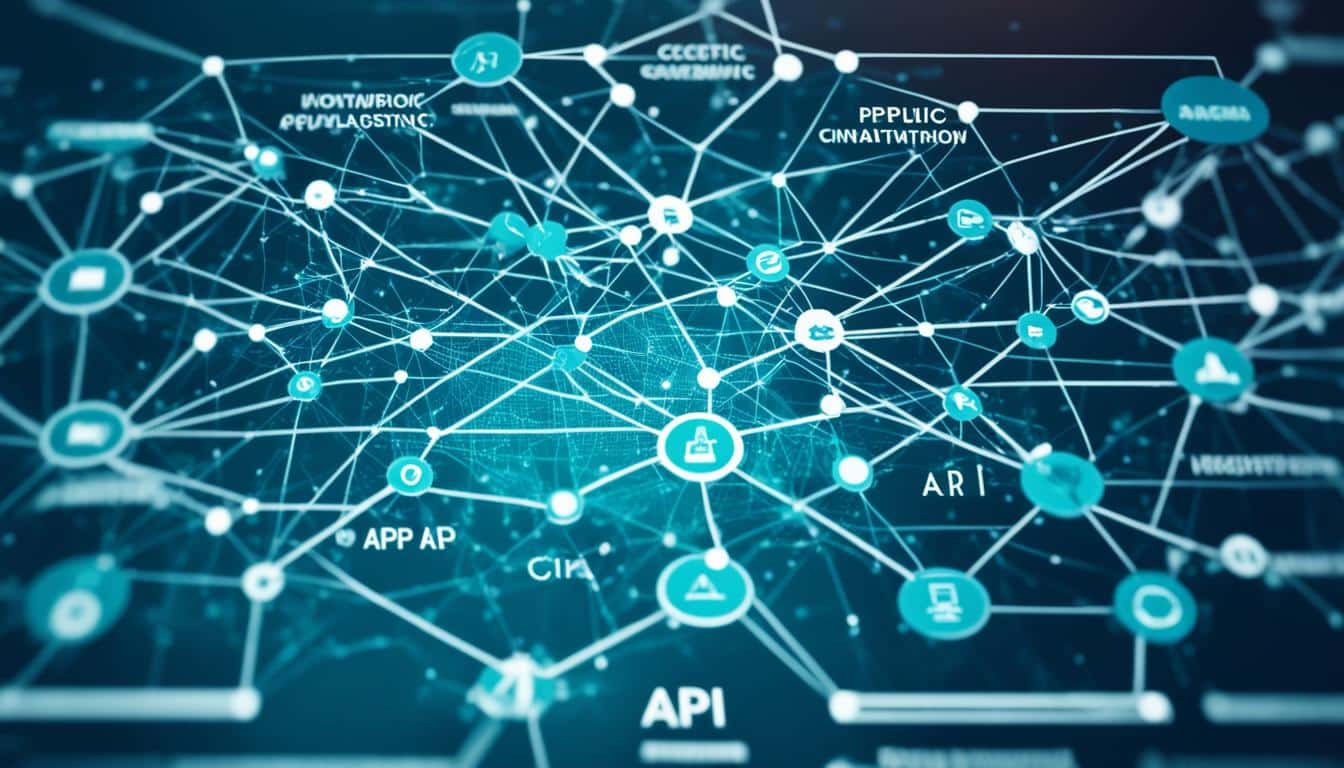Artificial Intelligences (AI) is driving a wave of innovation across industries, revolutionizing how businesses operate and paving the way for remarkable strides in technology. From AI technology and machine learning to deep learning, natural language processing, data analytics, neural networks, computer vision, automation, and robotics, the possibilities are vast and transformative.
McKinsey & Company estimates that AI could contribute trillions of dollars annually to the global economy, highlighting its potential to reshape the world as we know it. To stay ahead in this rapidly evolving landscape, it is crucial to explore the latest AI trends and insights, enabling businesses to harness the full power of AI for their advantage.
Key Takeaways:
- Artificial Intelligence (AI) is revolutionizing industries and driving business innovation.
- McKinsey & Company estimates that AI has the potential to add trillions of dollars to the global economy.
- Stay informed about the latest AI trends and insights to leverage AI’s full potential.
- Explore AI technology, machine learning, deep learning, natural language processing, data analytics, neural networks, computer vision, automation, and robotics.
- Embrace AI as a strategic asset for your business’s growth and success.
Bespoke Enterprise Solutions
Businesses are increasingly embracing bespoke AI solutions to meet their specific requirements. These tailor-made AI solutions are designed to cater to the unique needs of organizations, enabling them to achieve maximum functionality and efficiency. Unlike off-the-shelf AI tools, bespoke solutions are customized to extract meaningful insights and drive impactful outcomes.
Also Read : Essential Guide to 3D Printing Technology
Generative AI tools play a pivotal role in the development of bespoke AI solutions. These advanced tools utilize proprietary data to enhance accuracy and relevance, empowering businesses to deliver highly personalized and tailored customer experiences. By leveraging generative AI technology, organizations can optimize decision-making processes, automate operations, and unlock new avenues for growth.
Also Read : Exploring Blockchain Technology Innovations & Uses
One of the key advantages of bespoke AI solutions is their ability to address specific pain points and challenges faced by enterprises. By analyzing and understanding the unique requirements of a business, AI models can be fine-tuned and customized to deliver superior performance and outcomes. This level of customization ensures that businesses can harness the full potential of AI technology to gain a competitive edge in their respective industries.
Also Read : Essential Smart Home Devices for Easy Living
Moreover, bespoke AI solutions offer scalability and flexibility, allowing businesses to adapt and evolve their AI capabilities as their needs change. This agility enables organizations to remain future-proof and agile in the face of evolving market dynamics and technological advancements.
Also Read : Top Software Development Tools & Solutions 2024
Overall, the adoption of bespoke AI solutions and generative AI tools is revolutionizing the way businesses leverage AI technology. Organizations that embrace these tailored solutions are well-positioned to unleash the power of AI in achieving their strategic objectives, driving innovation, and transforming industry landscapes.
Also Read : Quality Custom Mobile App Development Services
Image:
Benefits of Bespoke AI Solutions
| Benefits | Description |
|---|---|
| Customization | Bespoke AI solutions are tailored to meet the specific needs and requirements of businesses, ensuring optimal performance and functionality. |
| Precision and Accuracy | Generative AI tools enhance accuracy and relevance, enabling businesses to extract valuable insights and make data-driven decisions. |
| Competitive Advantage | By adopting bespoke AI solutions, organizations can gain a competitive edge by leveraging AI technology that is fine-tuned to their industry and specific challenges. |
| Scalability and Flexibility | Bespoke solutions offer scalability and flexibility, allowing organizations to adapt and expand their AI capabilities as their needs evolve. |
| Innovation and Transformation | Embracing bespoke AI solutions encourages innovation and drives transformation within industries, enabling businesses to stay ahead of the curve. |
The Emergence of Open-Source Artificial intelligences Models
The adoption of open-source AI models is on the rise, revolutionizing AI development and leading to significant cost reduction. This trend democratizes AI, making it accessible to businesses of all sizes and sectors. By leveraging open-source AI models, companies can blend these models with their data, enabling faster innovation and improved efficiency.
Open-source AI models offer a wealth of benefits, including:
- Reduced development costs: Open-source AI models eliminate the need to build AI capabilities from scratch, saving resources and time.
- Accelerated AI deployment: Businesses can quickly integrate pre-trained models into their existing systems, speeding up implementation.
- Improved accuracy and performance: Collaborative development and continuous updates enhance the quality and reliability of open-source AI models.
- Community-driven innovation: Open-source communities foster collaboration and knowledge sharing, driving advancements in AI technology.
An excellent example of the power of open-source AI models is IBM’s collaboration with NASA on a geospatial AI model. This partnership utilized open-source technologies to develop an AI model that analyzes satellite imagery to monitor and predict climate patterns. By pooling their expertise and resources, IBM and NASA have demonstrated how open-source AI can drive meaningful advancements in critical sectors.
Open-source AI Models vs. Proprietary Solutions
“Open-source AI models offer businesses tremendous opportunities for innovation and cost reduction. By tapping into the collective wisdom and contributions of the open-source community, organizations can leverage cutting-edge AI technology without prohibitive development costs.”
Compared to proprietary AI solutions, open-source models unlock greater flexibility and customization potential. Businesses are no longer bound by the limitations of closed systems and can tailor open-source models to their unique needs. This adaptability enables companies to develop AI solutions that align precisely with their specific requirements, leading to enhanced performance and results.
Furthermore, open-source AI models foster collaboration and knowledge sharing among developers, researchers, and businesses. This collective effort drives the overall advancement of AI technology and accelerates the pace of innovation.
As the use of open-source AI models becomes more prevalent, it is vital for businesses to cultivate a strong understanding of model accessibility, licensing, and community support. Regularly engaging with the open-source community ensures access to the latest updates, improvements, and best practices.

| Open-Source AI Model | Benefits |
|---|---|
| TensorFlow | Allows developers to build and deploy machine learning models across different platforms. |
| PyTorch | Provides dynamic computational graphs for easier model building and debugging. |
| FastText | Enables efficient text classification and representation learning. |
| GPT-3 | Delivers state-of-the-art natural language processing capabilities for various applications. |
Rise of API-centric AI Services
The fast-paced market environment has propelled the rise of API-centric AI services, revolutionizing the integration of complex AI solutions. Application programming interfaces (APIs) are simplifying the process, offering seamless connectivity between various AI technologies and systems. Companies like IBM have taken advantage of this trend by providing AI microservices specifically tailored to meet the demands of different industries.
API-centric AI services allow businesses to enhance their customer interaction analysis, inventory management, and overall operational efficiency. By leveraging AI microservices, organizations gain the ability to extract real-time insights, automate repetitive tasks, and optimize decision-making processes. This agility and adaptability have become essential in the dynamic business landscape.
Benefits of API-centric AI Services
API-centric AI services offer numerous benefits in this fast-paced market environment:
- Scalability: API-driven AI solutions can be easily scaled up or down according to shifting business requirements, enabling organizations to adapt quickly to market demands.
- Customization: With the availability of AI microservices, businesses can select and integrate specific AI capabilities to tailor solutions that align with their unique needs.
- Efficiency: The streamlined integration process results in faster deployment and implementation of AI technologies, saving valuable time and resources.
- Cost-effectiveness: API-centric AI services often offer a pay-per-use model, allowing businesses to optimize costs by only paying for the specific AI capabilities utilized.
Furthermore, API-centric AI services empower organizations to leverage the collective power of multiple AI technologies through seamless integration. This enables them to maximize the value derived from AI while minimizing the complexities typically associated with AI implementation.
Companies like IBM are at the forefront of this API-centric AI revolution, offering a wide range of AI microservices designed to meet the specific needs of industries such as healthcare, finance, and retail. By providing accessible and adaptable AI solutions, businesses can leverage these services to gain a competitive edge in the market.
In summary, the rise of API-centric AI services has transformed the way businesses integrate and leverage AI technologies. This shift has brought about increased scalability, customization, efficiency, and cost-effectiveness, allowing organizations to thrive in today’s fast-paced market environment.

AI as a Strategic National Agenda
Countries around the world are recognizing the importance of AI as a top-tier strategic initiative. As nations strive for economic growth and competitiveness, AI is being embraced as a crucial tool to drive innovation and foster technological advancement. One notable example of this prioritization is the European Union’s implementation of the EU Artificial Intelligence Act, which signifies a significant step towards comprehensive AI governance.
The EU Artificial Intelligence Act sets the stage for the responsible development and application of AI across various sectors and risk levels. It addresses both the opportunities and challenges associated with AI, emphasizing the need for transparent and accountable AI systems. By establishing a regulatory framework, the EU aims to create a conducive environment for AI innovation while safeguarding ethical considerations.
This comprehensive AI governance approach encompasses various aspects, including:
- AI principles and requirements: The EU Artificial Intelligence Act defines clear principles and requirements for AI systems, ensuring fairness, safety, and transparency in their operation.
- High-risk AI: The act identifies high-risk AI applications, which require additional scrutiny and compliance with strict regulatory standards. This includes sectors such as healthcare, transportation, and critical infrastructure.
- Data governance: With data being a crucial component of AI systems, the act emphasizes the importance of data protection, privacy, and responsible data usage.
- Regulatory oversight: The act establishes a regulatory framework to monitor and supervise AI developments, ensuring compliance with ethical and legal standards.
| Benefits of Comprehensive AI Governance | Challenges Addressed |
|---|---|
|
|
The EU Artificial Intelligence Act serves as a model for other countries striving to establish comprehensive AI governance frameworks. It sets a precedent for proactive regulation, ensuring that AI technologies are developed and deployed in a manner that aligns with societal values and aspirations. As nations embrace AI as a strategic national agenda, the collaborative efforts towards responsible AI development will shape the future of AI applications.
The Advent of Multimodal Generative AI
The rapid advancement of AI technology has paved the way for groundbreaking innovations in various industries. One notable development is the emergence of multimodal generative AI, which integrates text, speech, and imagery to provide context-aware responses. This transformative capability is set to revolutionize how AI interacts with users and offers tailored solutions.
In the banking industry, for example, multimodal AI enables financial institutions to analyze multiple inputs simultaneously and generate context-aware responses that are tailored to each customer’s unique needs. By considering factors like past transactions, current financial goals, and even visual cues from images or documents, multimodal generative AI can offer personalized and relevant financial advice in real-time.
This shift towards multimodal AI not only enhances the customer experience but also enables businesses to deliver more accurate and tailored services. The ability to process and understand various modes of communication opens up new possibilities for AI’s role in sectors such as healthcare, customer service, and e-commerce.
“Multimodal generative AI allows us to create a more immersive and personalized experience for our customers,” says Sarah Thompson, CEO of a leading fintech company. “By analyzing both textual and visual data, we can provide tailored financial advice that takes into account the specific circumstances and goals of each individual.”
This remarkable advancement in AI technology has the potential to revolutionize industries, empower organizations, and improve customer satisfaction. With its ability to analyze and interpret multiple modes of input, multimodal generative AI is set to transform the way businesses operate and interact with their customers.
With multimodal AI, businesses can harness the power of context-aware responses and provide tailored financial advice. This is just the beginning of the exciting possibilities that multimodal generative AI brings to the table.

Prioritizing AI Safety and Ethical Practices
As AI becomes more prevalent in everyday life, ensuring its safety and ethical application is crucial. The rapid advancement of AI technology has raised concerns about its potential risks and implications. Therefore, it is essential to prioritize AI safety and adhere to ethical practices in its development and deployment.
Recognizing the significance of this issue, collaborative efforts such as the AI Safety Alliance have emerged to address these concerns. Through a multidisciplinary approach, the alliance focuses on developing standardized safety protocols and promoting ethical AI practices across industries.
“AI has the potential to transform society in unprecedented ways. However, it is equally important to ensure that AI systems are designed and implemented responsibly. By establishing standardized safety protocols and ethical practices, we can harness the power of AI while mitigating its potential risks.”
Standardized safety protocols in AI development provide a framework through which organizations can navigate the complexities of ensuring AI safety. These protocols encompass various aspects, including data privacy, transparency, bias mitigation, and explainability. By adhering to these protocols, businesses can build trust and confidence among users and stakeholders.
Ethical AI practices go beyond ensuring safety and extend to addressing the broader societal impact of AI technology. This includes considerations such as fairness, accountability, and the preservation of human values. Ethical AI practices guide organizations in making responsible decisions and fostering trust in AI systems.
By prioritizing AI safety and ethical practices, we can pave the way for the responsible development and deployment of AI technology. This not only mitigates potential risks but also enhances the overall trust and acceptance of AI by society.
To create a visual representation of the importance of AI safety and ethical practices, consider the following table:
| Importance | Benefits |
|---|---|
| 1. Mitigating AI risks | – Avoiding unintended consequences – Minimizing bias and discrimination – Preventing misuse of AI |
| 2. Building trust | – Gaining user and stakeholder confidence – Ensuring transparency and accountability – Preserving privacy and data security |
| 3. Fostering societal acceptance | – Promoting ethical AI applications – Addressing the impact on jobs and social equity – Upholding human values and rights |
By integrating AI safety measures and ethical practices into AI development and deployment, we can unlock the full potential of AI technology while ensuring its responsible and beneficial use.

Navigating the AI-Driven Future
The future of Artificial Intelligence (AI) holds immense potential for driving innovations and societal progress. As AI continues to evolve and advance, staying informed and adaptable becomes crucial in order to harness its full capabilities and shape a more efficient, creative, and inclusive world. With AI becoming increasingly integrated into various industries and sectors, businesses need to develop effective strategies to leverage its transformative power.
Understanding AI trends is key to navigating this rapidly changing landscape. By staying ahead of the curve, businesses can anticipate the latest advancements and adapt their strategies accordingly. It’s essential to keep a finger on the pulse of emerging technologies, industry trends, and market dynamics to harness the true potential of AI for driving growth and success.
One of the significant drivers of societal progress is the strategic implementation of AI in various domains. From healthcare and finance to transportation and entertainment, AI is revolutionizing how industries operate. For example, AI-powered healthcare technologies enable personalized patient care and diagnostic accuracy, while AI-driven financial solutions provide tailored advice and optimize investment strategies.
When it comes to business strategies, incorporating AI into operations can lead to improved efficiency, enhanced decision-making, and increased profitability. AI-driven automation streamlines processes, reduces manual errors, and enables faster data-driven insights. By leveraging AI to its full extent, businesses can gain a competitive edge and deliver superior products and services to their customers.
“The integration of AI technology is revolutionizing industries and reshaping the future.”
As AI continues to advance, it’s crucial to prioritize ethical practices and maintain safety standards. Responsible AI usage considers the potential impact on society and ensures that AI systems are fair, transparent, and unbiased. By establishing standardized safety protocols and ethical guidelines, businesses can build trust in AI technology and ensure its responsible deployment.
As we navigate the AI-driven future, it’s important to recognize that the journey has just begun. The full extent of AI’s impact is yet to be realized, with new breakthroughs and applications emerging continuously. By embracing AI trends, fostering societal progress, and developing sound business strategies, organizations can position themselves to thrive in this era of technological transformation.
“Staying informed and adaptable is key to leveraging AI’s full potential and crafting a more efficient, creative, and inclusive world.”
To visualize the transformative power of AI, here’s a glimpse of a future scenario:
| AI Trend | Societal Progress | Business Strategies |
|---|---|---|
| AI-powered autonomous vehicles | Reduced traffic congestion, enhanced safety | Investment in logistics, ride-sharing services |
| AI-assisted healthcare diagnostics | Improved disease detection, personalized treatment | Integration of AI into medical devices and systems |
| Natural language processing | Efficient communication with AI-powered chatbots | Deployment of chatbot customer support services |
These examples illustrate how AI trends can drive societal progress and offer valuable opportunities for businesses to strategize and adapt. As we navigate the AI-driven future, it is essential to remain agile, embrace innovation, and seize the transformative potential of AI across industries.
Also Read : Essential Guide to 3D Printing Technology

Conclusion
The integration of AI technology is revolutionizing industries and reshaping the future. With bespoke AI solutions, open-source models, and API-centric services, businesses are leveraging AI’s potential to drive innovation and enhance their strategies. However, it is crucial to prioritize AI safety and ethical practices to ensure responsible AI development.
As we navigate the AI-driven future, staying informed and adaptable is essential. The impact of AI is widespread and its potential is vast, offering exciting opportunities for societal progress and economic growth. By staying abreast of AI trends and developments, businesses can effectively leverage AI’s capabilities to craft a more efficient, creative, and inclusive world.
The future of AI holds great promise. As new technologies emerge and AI continues to evolve, it is important for organizations to keep up with the latest advancements and embrace AI as a strategic tool. By harnessing the power of AI, businesses can unlock new possibilities, improve decision-making processes, and gain a competitive edge in their respective industries.
FAQs
Q: How does AI work?
A: AI systems work by processing large amounts of data, identifying patterns, and making decisions based on that information using algorithms and learning techniques.
Q: Why is artificial intelligence important?
A: Artificial intelligence is important because it has the potential to revolutionize industries, improve efficiency, and solve complex problems that were previously impossible for humans to tackle.
Q: What is the history of AI?
A: The history of artificial intelligence dates back to the 1950s when early AI research began. Over the years, AI technologies have evolved significantly, leading to advancements in machine learning and deep learning techniques.
Q: What are the benefits of AI?
A: Some benefits of AI include automation of manual tasks, improved decision-making, enhanced efficiency, and the ability to process and analyze large amounts of data quickly.
Q: What are the main types of artificial intelligence?
A: The main types of artificial intelligence are weak AI (narrow AI) and strong AI (artificial general intelligence). Weak AI is designed to perform a narrow task, while strong AI aims to replicate the cognitive abilities of humans.
Q: How does artificial intelligence work?
A: Artificial intelligence works by using algorithms and learning techniques to analyze data, make predictions, and solve problems. It involves processes like machine learning, deep learning, and neural networks.
Q: Why is artificial intelligence important?
A: Artificial intelligence is important because it has the potential to revolutionize industries, improve efficiency, accelerate innovation, and enhance decision-making processes. It also has the power to address complex challenges and improve human lives.
Q: What is the history of artificial intelligence?
A: The history of artificial intelligence dates back to the mid-20th century, with significant milestones in the development of AI techniques, algorithms, and technologies. Early AI research laid the foundation for modern AI applications and advancements.
Q: What are the benefits of artificial intelligence?
A: The benefits of artificial intelligence include improved efficiency, automation of tedious tasks, better decision-making, enhanced accuracy, increased productivity, and the ability to handle large volumes of data effectively.
Q: What is machine learning in the context of artificial intelligence?
A: Machine learning is a subset of artificial intelligence that focuses on developing algorithms and models that enable computers to learn from data and make predictions or decisions without being explicitly programmed.
Q: What are AI tools commonly used in artificial intelligence development?
A: AI tools used in artificial intelligence development include neural networks, machine learning libraries like TensorFlow and scikit-learn, natural language processing tools, computer vision libraries, and AI development platforms.


